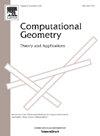Algorithms for computing closest points for segments
IF 0.7
4区 计算机科学
Q4 MATHEMATICS
Computational Geometry-Theory and Applications
Pub Date : 2025-04-17
DOI:10.1016/j.comgeo.2025.102196
引用次数: 0
Abstract
Given a set P of n points and a set S of n segments in the plane, we consider the problem of computing for each segment of S its closest point in P. The previously best algorithm solves the problem in time [Bespamyatnikh, 2003] and a lower bound (under a somewhat restricted model) has also been proved. In this paper, we present an time algorithm, which matches the above lower bound. In addition, we also present data structures for solving the online version of the problem, i.e., given a query segment (or a line as a special case), find its closest point in P. Our new results improve the previous work.
计算线段最近点的算法
给定平面上n个点的集合P和n个线段的集合S,我们考虑计算S的每个线段在P中的最近点的问题。先前最好的算法在n4/32O(log n)时间内解决了这个问题[Bespamyatnikh, 2003],并且证明了一个下界(在某种程度上受限的模型下)Ω(n4/3)。在本文中,我们提出了一个O(n4/3)时间算法,该算法与上述下界匹配。此外,我们还提供了用于解决在线版本问题的数据结构,即给定查询段(或作为特殊情况的一行),在p中找到其最近点。我们的新结果改进了以前的工作。
本文章由计算机程序翻译,如有差异,请以英文原文为准。
求助全文
约1分钟内获得全文
求助全文
来源期刊
CiteScore
1.60
自引率
16.70%
发文量
43
审稿时长
>12 weeks
期刊介绍:
Computational Geometry is a forum for research in theoretical and applied aspects of computational geometry. The journal publishes fundamental research in all areas of the subject, as well as disseminating information on the applications, techniques, and use of computational geometry. Computational Geometry publishes articles on the design and analysis of geometric algorithms. All aspects of computational geometry are covered, including the numerical, graph theoretical and combinatorial aspects. Also welcomed are computational geometry solutions to fundamental problems arising in computer graphics, pattern recognition, robotics, image processing, CAD-CAM, VLSI design and geographical information systems.
Computational Geometry features a special section containing open problems and concise reports on implementations of computational geometry tools.

 求助内容:
求助内容: 应助结果提醒方式:
应助结果提醒方式:


